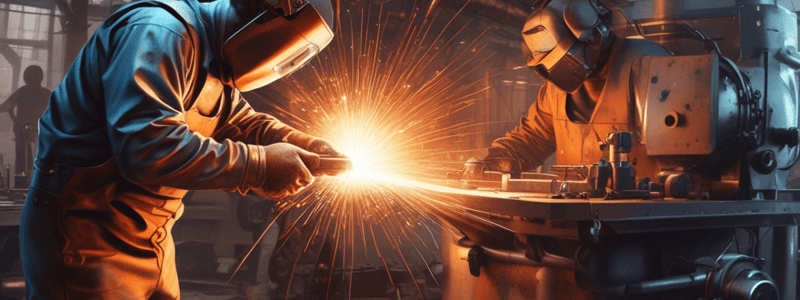Podcast
Questions and Answers
In which century were the present day welding processes developed?
In which century were the present day welding processes developed?
- Within a period of about 50 years
- 19th century
- 20th century
- Last century (correct)
What type of welding process is used when no filler metal is used?
What type of welding process is used when no filler metal is used?
- Manual Metal Arc Welding Process
- Forge Welding Process
- Autogenous Welding Process (correct)
- Oxy-Acetylene Welding Process
In which year was the first application of welding with carbon electrode developed?
In which year was the first application of welding with carbon electrode developed?
- 1902
- 1905
- 1890
- 1885 (correct)
What led to the feasibility of oxy-acetylene welding in Europe in 1903?
What led to the feasibility of oxy-acetylene welding in Europe in 1903?
When was resistance butt welding invented in the USA?
When was resistance butt welding invented in the USA?
What was the significance of developments in 1885 and 1890?
What was the significance of developments in 1885 and 1890?
What is the year when the first all-welded bridge was erected in the UK?
What is the year when the first all-welded bridge was erected in the UK?
What is the primary reason why welding replaced riveting in ship building?
What is the primary reason why welding replaced riveting in ship building?
What is the year when welding started to be used in the fabrication of pressure vessels?
What is the year when welding started to be used in the fabrication of pressure vessels?
What is the primary reason why welding was initially used in bridge construction in Australia?
What is the primary reason why welding was initially used in bridge construction in Australia?
What is the year when the problem of fracture in welded structures was highlighted?
What is the year when the problem of fracture in welded structures was highlighted?
What is the year when the process of submerged arc welding was developed?
What is the year when the process of submerged arc welding was developed?
What is the primary reason why the classification of welding processes based on the source of energy is not justified?
What is the primary reason why the classification of welding processes based on the source of energy is not justified?
What is the main limitation of the classification of welding processes based on the presence or absence of filler material?
What is the main limitation of the classification of welding processes based on the presence or absence of filler material?
What is the primary application of micro-joining in the industry?
What is the primary application of micro-joining in the industry?
What is the main difference between fusion welding and pressure welding?
What is the main difference between fusion welding and pressure welding?
What is the primary application of welding in the nuclear industry?
What is the primary application of welding in the nuclear industry?
What is the limitation of the classification of welding processes based on arc and non-arc welding?
What is the limitation of the classification of welding processes based on arc and non-arc welding?
What is the primary purpose of welding symbols in welding engineering?
What is the primary purpose of welding symbols in welding engineering?
Which type of weld joint is formed when two plates are approximately perpendicular to each other at one side of the plates being welded?
Which type of weld joint is formed when two plates are approximately perpendicular to each other at one side of the plates being welded?
What is the term used to describe the process of gas metal arc welding when an active gas such as CO2 or a mixture of inert and active gases is used as the shielding gas?
What is the term used to describe the process of gas metal arc welding when an active gas such as CO2 or a mixture of inert and active gases is used as the shielding gas?
What is the requirement of the power source for GMAW process?
What is the requirement of the power source for GMAW process?
What is the purpose of the copper coating on the electrode wire in GMAW process?
What is the purpose of the copper coating on the electrode wire in GMAW process?
What is the term used to describe the type of weld that is made by melting the edges of two plates to be welded?
What is the term used to describe the type of weld that is made by melting the edges of two plates to be welded?
What is the main factor that determines the range of welding current and voltage in GMA welding?
What is the main factor that determines the range of welding current and voltage in GMA welding?
What is the typical shielding gas used for welding mild steel in GMA welding?
What is the typical shielding gas used for welding mild steel in GMA welding?
What is the primary reason why GMA welding is preferred over manual metal arc welding for welding nonferrous metals like aluminum and copper based alloys?
What is the primary reason why GMA welding is preferred over manual metal arc welding for welding nonferrous metals like aluminum and copper based alloys?
What is the primary purpose of using flux in forge welding?
What is the primary purpose of using flux in forge welding?
What is the main advantage of GMA welding over other arc welding processes?
What is the main advantage of GMA welding over other arc welding processes?
What is the effect of air draught on the GMA welding process?
What is the effect of air draught on the GMA welding process?
What is the approximate temperature range for heating the workpieces in forge welding?
What is the approximate temperature range for heating the workpieces in forge welding?
What is the primary reason why GMA welding is used in industries such as shipbuilding and chemical plants?
What is the primary reason why GMA welding is used in industries such as shipbuilding and chemical plants?
What type of welding process is forge welding?
What type of welding process is forge welding?
What is the result of repeated hammering or high pressure load on the workpieces in forge welding?
What is the result of repeated hammering or high pressure load on the workpieces in forge welding?
What is the main requirement for the interface surface of the plates in forge welding?
What is the main requirement for the interface surface of the plates in forge welding?
What is the primary tool used for manual hammering in forge welding?
What is the primary tool used for manual hammering in forge welding?
What is the primary use of mechanical hammering in forge welding?
What is the primary use of mechanical hammering in forge welding?
What is the primary material joined using forge welding?
What is the primary material joined using forge welding?
What is the primary use of dies in forge welding?
What is the primary use of dies in forge welding?
What is the primary historical use of forge welding?
What is the primary historical use of forge welding?
Flashcards are hidden until you start studying
Study Notes
Welding
- Welding is the process of joining two metallic components with the application of heat, with or without the application of pressure, and with or without the use of filler metal.
- Heat can be obtained by chemical reaction, electric arc, electrical resistance, frictional heat, sound, and light energy.
History of Welding
- During the Bronze Age, parts were joined by forge welding to produce tools, weapons, and ornaments.
- The first application of welding with a carbon electrode was developed in 1885.
- Metal arc welding with a bare electrode was patented in 1890.
- Resistance butt welding was invented in the USA in 1886.
- Other resistance welding processes such as spot and flash welding were developed around 1905.
- The production of cheap oxygen in 1902 led to the development of oxy-acetylene welding in Europe in 1903.
- The development of coated electrodes in 1907 made manual metal arc welding viable for production and fabrication.
Types of Welding
- Thermit welding (1903)
- Cellulosic electrodes (1918)
- Arc stud welding (1918)
- Seam welding of tubes (1922)
- Mechanical flash welder for joining rails (1924)
- Extruded coating for MMAW electrodes (1926)
- Submerged arc welding (1935)
- Air arc gouging (1939)
- Inert gas tungsten arc (TIG) welding (1941)
- Iron powder electrodes with high recovery (1944)
- Inert gas metal arc (MIG) welding (1948)
- Electro slag welding (1951)
- Flux cored wire with CO2 shielding (1954)
- Electron beam welding (1954)
- Constricted arc (plasma) for cutting (1955)
- Friction welding (1956)
- Plasma arc welding (1957)
- Electro gas welding (1957)
- Short circuit transfer for low current, low voltage welding with CO2 shielding (1957)
- Vacuum diffusion welding (1959)
- Explosive welding (1960)
- Laser beam welding (1961)
- High-power CO2 laser beam welding (1964)
Applications of Welding
- Fabrication of pressure vessels, bridges, building structures, aircraft, and space crafts
- Shipbuilding, automobile, electrical, electronic, and defense industries
- Laying of pipelines and railway tracks
- Nuclear installations
- Construction of transport tankers, welded tubes, and pipes
- Steel furniture, gates, doors, and other items
- Micro-joining (junctions of thermocouples, strain gauges to wire leads, etc.)
Classification of Welding Processes
- Welding with or without filler material
- Source of energy of welding
- Arc and non-arc welding
- Fusion and pressure welding
- Fusion welding (molten metal solidifies freely)
- Pressure welding (molten metal, if any, is retained in a confined space under pressure)
Welding Symbols
- Symbols used to show the type of weld to be made
- Symbols used to show not only the type of weld but also relevant aspects related to welding (size, location, welding process, edge preparation, bead geometry, etc.)
Types of Weld Joints
- Butt joint (plates in the same horizontal plane, aligned with a maximum deviation of 50)
- Lap joint (plates overlapping each other, with the overlap on one or both sides)
- Corner joint (joint made by melting the corners of two plates, approximately perpendicular to each other)
- Edge joint (joint made by melting the edges of two plates, almost parallel)
- T joint (one plate approximately perpendicular to another plate)
Types of Welds
- Groove weld
- Fillet weld
- Plug weld
- Bead on plate weld
Gas Metal Arc Welding (GMAW)
- Process in which an arc is struck between a bare wire electrode and the workpiece
- Arc is shielded by a shielding gas (inert or active)
- Electrode wire is fed continuously through a contact tube
- Power source is a direct current (DC) flat characteristic
- Electrode wire is connected to the positive terminal of the power source
- Shielding gases used: argon, helium, CO2, and mixtures
- Wire feeding system: pressure adjusting screw, wire feeding rolls, and grooves
Arc Welding Process
- Applies heat generated by an electric arc to melt the faying surfaces of the base metal
- Common arc welding processes: manual metal or shielded metal arc welding (MMA or SMA), metal inert gas arc (MIG), tungsten inert gas (TIG), submerged arc (SA), plasma arc (PA), and carbon arc (CA)
Forge Welding
- A solid-state welding process in which both plates are heated below their melting temperature
- Plastic deformation occurs, and inter-molecular diffusion takes place at the interface surface
- Requires a clean interface surface, free from oxide or other contaminant particles
- Flux is used to prevent oxidation and to flow out the oxide layer during heating and hammering
Studying That Suits You
Use AI to generate personalized quizzes and flashcards to suit your learning preferences.





